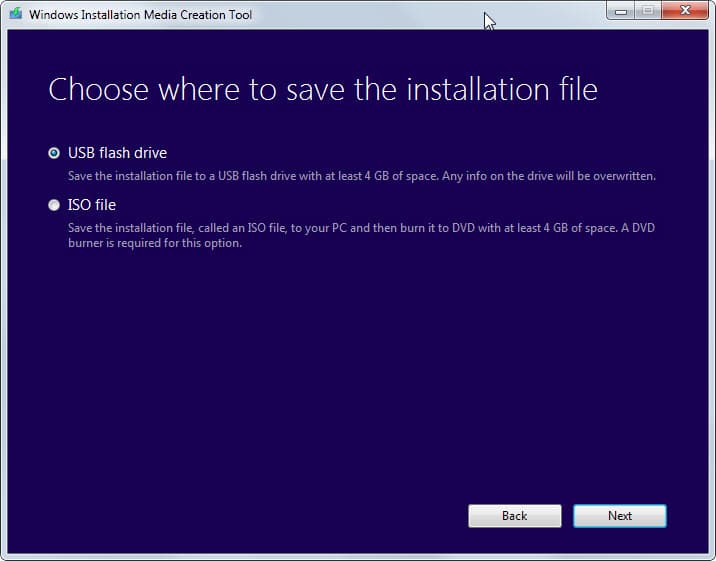

- MEDIA CREATION TOOL WINDOWS 7 BOOTABLE DVD INSTALL
- MEDIA CREATION TOOL WINDOWS 7 BOOTABLE DVD WINDOWS 10
- MEDIA CREATION TOOL WINDOWS 7 BOOTABLE DVD PC
- MEDIA CREATION TOOL WINDOWS 7 BOOTABLE DVD ISO

MEDIA CREATION TOOL WINDOWS 7 BOOTABLE DVD ISO
With its help, you can create a bootable disk or an ISO image to deploy Windows 11 with ease.
MEDIA CREATION TOOL WINDOWS 7 BOOTABLE DVD PC
Media Creation Tool comes in handy in situations when you want to try or reinstall Windows 11 on your PC and do not own an installation media. You can then use a disc burner to create a DVD containing the Windows deployment files. Alternatively, the application can generate an ISO image and save it to your PC. Create a bootable USB or an ISO imageĭownloaded files can be sent to a USB flash drive, but note that at least 8 GB of free space are required and that all the information stored on the USB drive is overwritten during the process.
MEDIA CREATION TOOL WINDOWS 7 BOOTABLE DVD INSTALL
ISO file that you can burn on to a DVD to install the operating system on a different computer.
MEDIA CREATION TOOL WINDOWS 7 BOOTABLE DVD WINDOWS 10
As you might imagine, its speed highly depends on the reliability of your Internet connection. Windows 10 Media Creation Tool is a free utility developed by Microsoft, which lets you create a Windows 10 installation USB drive or download its. In order to use it, your computer must be connected to the Internet, since all the installation files are downloaded from Microsoft. It actually consists of a wizard that guides you through all the necessary steps, making the entire process a matter of pressing a few 'Next' buttons. Wizard-like interface with clear optionsįocusing on ease of use, this application adopts a forthright approach, enabling you to have your Windows 11 deployment package ready in minutes.

Created by Microsoft itself, Media Creation Tool can help you easily create a setup file for Windows 11. Strictly MBR\NTFS only.If your computer is running Windows 10, you need a bootable disk to help you deploy Windows 11. It does not have an option for selecting MBR\GPT\FAT32, etc. The Windows 7 Tool mentioned in another reply will in fact create a flash drive for Windows 10, but only for Legacy Bios machines. When you download the ISO file, you must copy it onto a USB or DVD. Then simply install Windows onto your computer directly from your USB or DVD drive.

I have had mixed success with this as far as the media being bootable is concerned.Īlso. If you choose to download an ISO file so you can create a bootable file from a DVD or USB drive, copy the Windows ISO file onto your drive and then run the Windows USB/DVD Download Tool. Just dragging the relevant files onto a Flash Drive may or may not work. Some automatically detect the UEFI installation based on the GPT\FAT32 Flash Drive, and others require it toīe determined by a "Boot Options " selection.īTW. The installation process in UEFI machines can vary due to different Bios requirements as to how the Installation media is loaded. If these criterial are not met, the installation will fail. same as the HDD\SSD, but needs to use FAT32 File type. UEFI Bios machines require the HDD\SSD to be GPT type, and NTFS File structure.Ī wrinkle for the installation media on a Flash Drive is that the Flash Drive needs to be GPT type. The same applies to a Installation Flash Drive. Legacy Bios machines require the HDD\SSD to be MBR type, and NTFS File structure. (1) A non exhaustive list of Rufus supported ISOs is also provided at the bottom of this. It is also marginally faster on the creation of Linux bootable USB from ISOs. And is therefore usable for any machine simply by reburning it to media.Īt one time this was not a problem, but with the emergence of UEFI Bios machines, there was a bit of a wrench thrown into the works. For instance it's about twice as fast as UNetbootin, Universal USB Installer or Windows 7 USB download tool, on the creation of a Windows 7 USB installation drive from an ISO. If you use the Media Creation Tool to simply download a ISO, the ISO can be put on media specifically for the intended machine using RUFUS for instance. I have encountered a number of threads in which the Flash Drive created by the Media Creation process would not work with a UEFI Bios machine. It can create media for the machine that it was run on, and not specifically for the machine that the media is intended for, and may not be compatible. The Media Creation Tool may or may not do what you need it to do as far as creating a Installation USB Flash Drive goes.įor instance.


 0 kommentar(er)
0 kommentar(er)
